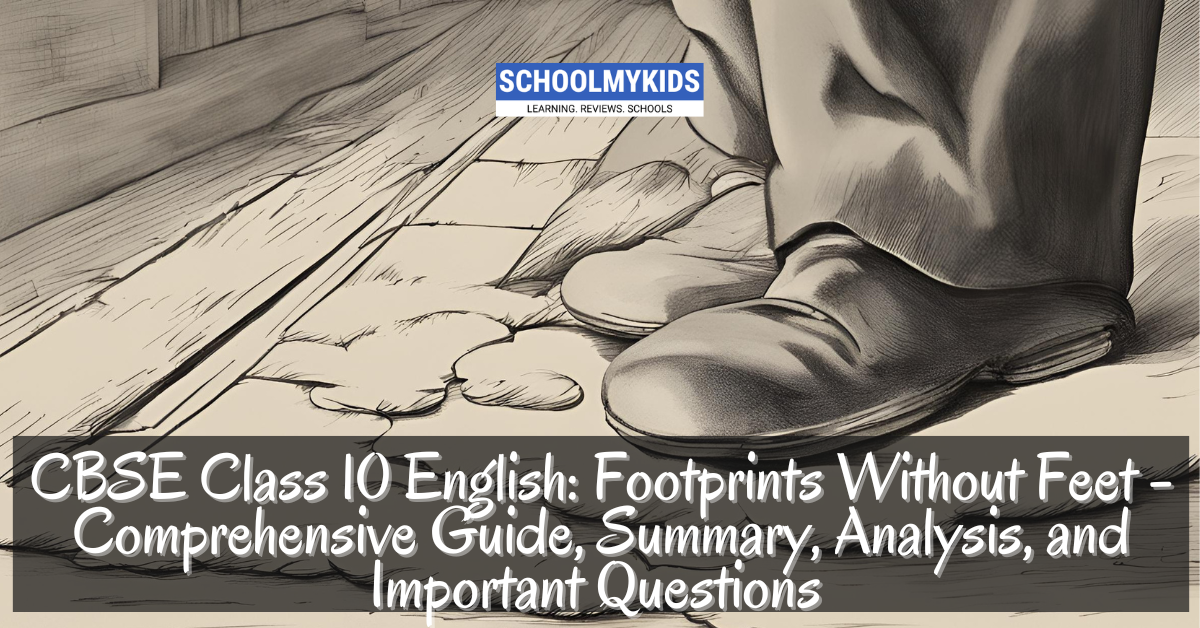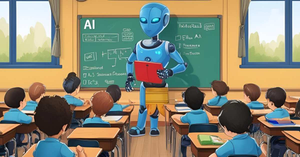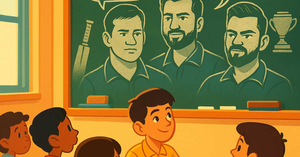“Footprints Without Feet” is a chapter from the Class 10 CBSE English textbook, “Footprints without Feet”
Summary
“Footprints Without Feet” is a fascinating story from the CBSE Class 10 English textbook, written by H.G. Wells. The story revolves around a brilliant scientist named Griffin, who discovers a way to make himself invisible. However, this scientific breakthrough leads to unexpected consequences and challenges that Griffin must navigate.
Griffin’s discovery of invisibility is a result of his extensive research and experiments with optics. His journey begins with his successful attempt to turn himself invisible. However, his invisibility comes with its own set of problems. Griffin cannot afford basic necessities and begins to use his invisibility to steal from shops and escape from tricky situations.
The story starts with two boys in London who spot fresh footprints on the ground with no one in sight. They follow the footprints and are led to Griffin, who is trying to escape after causing chaos. Griffin’s escapades continue as he terrorizes the landlord and others who come in his way. His invisibility, instead of being a boon, turns into a curse as he finds it increasingly difficult to live a normal life.
Griffin’s descent into madness is evident as he becomes more violent and desperate. His once brilliant mind is overshadowed by his criminal activities and erratic behaviour. The narrative explores the consequences of unchecked scientific advancement and raises ethical questions about the use of such power.
Analysis
“Footprints Without Feet” delves into themes of scientific exploration, ethics, and the consequences of power. Griffin’s invisibility, a symbol of scientific achievement, ultimately leads to his downfall, emphasizing the story’s moral lesson that power without responsibility can be destructive.
Griffin’s character is complex; he is a genius yet morally flawed. His initial excitement about his scientific discovery quickly turns into a nightmare as he struggles with the ethical implications of his actions. His invisibility grants him power, but it also isolates him from society, leading to his alienation and eventual madness.
The story also explores the theme of isolation. Griffin’s invisibility makes it impossible for him to interact normally with others, leading to his loneliness. His isolation is both physical and emotional, as he can no longer live a normal life or form meaningful relationships.
H.G. Wells skillfully uses imagery and suspense to engage the reader. The invisible footprints create a sense of mystery and intrigue, while Griffin’s actions create tension and anticipation. The story’s setting, in the bustling city of London, contrasts with Griffin’s invisible existence, highlighting his isolation.
Important Questions with Explanations
- What is the central theme of “Footprints Without Feet”?
- The central theme is the ethical implications of scientific advancement and the consequences of power without responsibility.
- Describe Griffin’s character.
- Griffin is a brilliant but morally flawed scientist. His discovery of invisibility leads him to criminal activities, showcasing his descent into madness and isolation.
- How does Griffin become invisible?
- Griffin becomes invisible through his experiments with optics, using a formula he discovered to render his body transparent.
- What challenges does Griffin face due to his invisibility?
- Griffin faces numerous challenges, including theft for survival, isolation from society, and the inability to interact normally with others.
- What is the significance of the title “Footprints Without Feet”?
- The title signifies the invisible presence of Griffin, highlighting the mysterious and eerie aspect of his existence.
- How does H.G. Wells create suspense in the story?
- Wells creates suspense through the mysterious invisible footprints, Griffin’s erratic behavior, and the tension in his interactions with others.
- What lesson does the story convey about scientific power?
- The story conveys that scientific power must be accompanied by ethical responsibility, as unchecked power can lead to destructive consequences.
- How does Griffin’s invisibility affect his mental state?
- Griffin’s invisibility leads to his isolation, paranoia, and eventual descent into madness as he becomes more desperate and violent.
- Analyze the theme of isolation in the story.
- Isolation is a key theme, as Griffin’s invisibility cuts him off from society, making him physically and emotionally isolated, leading to his downfall.
- Discuss the ethical implications of Griffin’s experiments.
- Griffin’s experiments raise ethical questions about the consequences of using scientific discoveries for personal gain and the responsibility of scientists to consider the impact of their work.
- What role do the two boys play in the story?
- The two boys serve as a narrative device to introduce Griffin’s invisible presence and set the stage for the unfolding mystery and chaos.
- How does the setting of London contribute to the story?
- The bustling city of London contrasts with Griffin’s invisible existence, emphasizing his isolation and the disruption he causes in a populated area.
- What is the impact of Griffin’s criminal activities on his character?
- Griffin’s criminal activities reveal his moral decline and desperation, showcasing how his invisibility, instead of being an asset, becomes a curse.
- How does Griffin’s invisibility symbolize power and its consequences?
- Griffin’s invisibility symbolizes unchecked power, which leads to his isolation, madness, and ultimate downfall, highlighting the destructive potential of power without responsibility.
- What is the significance of Griffin’s experiments with optics?
- Griffin’s experiments with optics represent human curiosity and the quest for knowledge, but also the ethical dilemmas and potential dangers associated with scientific advancements.
- How does the story explore the concept of responsibility in scientific discoveries?
- The story emphasizes that scientific discoveries must be handled with ethical responsibility, as misuse can have serious and destructive consequences.
- Analyze the narrative style of H.G. Wells in “Footprints Without Feet”.
- Wells’ narrative style is descriptive and suspenseful, effectively creating a sense of mystery and tension through vivid imagery and detailed descriptions.
- What role does Griffin’s appearance play in the story?
- Griffin’s invisibility makes his physical appearance irrelevant, focusing the story on his actions and their consequences rather than his looks.
- How does the story address the theme of human curiosity?
- The story highlights human curiosity through Griffin’s experiments, showing both the positive and negative outcomes of scientific exploration.
- What overall message does “Footprints Without Feet” convey?
- The story conveys that power and knowledge must be tempered with ethical considerations and responsibility, as misuse can lead to unintended and harmful consequences.
Conclusion
“Footprints Without Feet” by H.G. Wells is a thought-provoking story that explores themes of scientific ethics, power, and isolation. Through the character of Griffin, the story delves into the consequences of unchecked scientific advancements and the moral responsibilities that come with great power. For students preparing for the CBSE Class 10 English exam, understanding this story provides valuable insights into character development, thematic exploration, and narrative techniques, enriching their literary knowledge and analytical skills.









Be the first one to comment on this story.